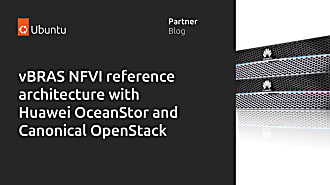anastasiavalti
on 6 January 2021
OpenStack for telcos by Canonical

What are the benefits of OpenStack for telcos today?
OpenStack has been around for a good while now, and many of us associate it with the period of IT technology’s initial transition from individual appliance implementation on hardware, to cloud compute and virtualisation. And yet in 2020 we cannot skip this topic when talking telco infrastructure.
So how is OpenStack still pertinent to telco organisations, and what in broad terms is new and exciting or worth discussing today about OpenStack?
Simply put, OpenStack remains at the heart of the telco infrastructure, as it is still the primary building block across an entire stack, consisting – for example – of MAAS for bare metal provisioning, Kubernetes for container orchestration, and Juju for operators. When thinking about an infrastructure like this, there’s still a need today for a software that’s managing distributed compute network and storage resources, exposing them as a single pool that’s available for the end users. And we see OpenStack constantly gaining momentum in that space.
What is Charmed OpenStack?
Canonical is a proud member of the OpenStack Foundation and a maintainer of the OpenStack Charms project, an official project hosted by the OpenStack Foundation, which builds one of the available distributions of OpenStack – Charmed OpenStack.
Through Charmed OpenStack, our aim is to provide an OpenStack distribution that’s deployable, maintainable and upgradable economically. We achieve all of that by putting full automation around OpenStack deployments and exposed deployment operations.
What is often the case with most tools available on the market, is that they help with the initial OpenStack set up but then once the cloud is built, once it’s handed over to the customer, the customer is left alone with the daily maintenance of the cloud. And OpenStack is a complex system. There are a lot of services contained in it that have to be configured, carefully interconnected so that they work together as a single instance as a cloud and actually provide the value they promise to the end user. That’s why the amount of time organisations have to spend on learning all of that and getting up to speed with OpenStack used to be a bottleneck in OpenStack’s adoption for many organisations.
Canonical’s goal is to strip off those layers of complexity so that what’s really left to handle by the user is a model of the OpenStack. In other words, users interact not just with the cloud itself, but with this model. This becomes possible through charms, which provide so-called ‘model driven deployments and operations’ of OpenStack.
What this means is that Charmed OpenStack can offer services such as smooth upgrades to new OpenStack versions, which is one of the key differentiators compared to what other OpenStack platforms are doing – like Red Hat, for example. It also allows organisations (given that the entire model is represented in the form of YAML file,) to integrate with various infrastructures, code solutions and CICD platforms as well.
The benefits of Charmed OpenStack for telcos
1. Networking speed
Charmed OpenStack answers all of the requirements coming from the telco sector, and one of them is fast networking.
Firstly, we should note that 100 Gbps networking with OVS hardware offloading is now becoming our reference architecture for NFVi implementation. But Charmed OpenStack also provides all of the other performance extensions that are important for telcos; such as SR-IOV, DPDK, CPU pinning, NUMA, and also numerous passthrough technologies like PCI passthrough and GPU passthrough.
2. Security and performance
Another point to address is the importance of security and performance for telcos. Charmed OpenStack provides up to 10 years of security updates under the Extended Security Maintenance program available for Canonical customers under the Ubuntu Advantage for Infrastructure subscription. Data encryption on the fly through TLS everywhere, and at rest, through building safe mechanisms.
Additionally, it offers extensive hardening for both the underlying Ubuntu operating system and OpenStack services; containerized control plane, with each individual OpenStack control service running in a separate LXE container and featuring full isolation and high security through AppArmor profiles. And finally, a Kernel Livepatch service which makes it possible to update the kernel of the underlying Ubuntu operating system without the need to reboot the hypervisors or the nodes where the OpenStack control services are running, if not using a hyperconverged architecture.
Charmed OpenStack is compliant with numerous standards, such as CIS or DISA, FIPS for crypto modules and other certification bodies.
3. SDN and storage
Canonical provides a variety of SDN options for telco customers. We promote open source technologies as default ones, which are used in our implementation. So OVS and Open Visual Network as a kind of extension to OVS, providing a fully functional open source SDN platform on the top of OVS. But we also support leading SDNs coming from big players in the networking market in general; Cisco and Juniper. And we cooperate with other vendors as well, to make sure that we provide the best possible services for both SDN and storage.
4. Stability of the underlying platform
Charmed OpenStack comes with a predictable release cadence and upgrade path. It is released every six months, very shortly after the upstream OpenStack release. Every two years Canonical issues an LTS version of OpenStack, long term supported, that comes along with the LTS version of Ubuntu. And for each of those LTS releases, we provide five years of security updates and an additional five years of security patches. So telcos can choose whether they want to upgrade on a regular basis, or whether they want to stay with their LTS if they’re not really considering an upgrade





